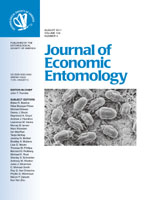Traps baited with disparlure, the synthetic form of the gypsy moth, Lymantria dispar (L.) (Lepidoptera: Lymantriidae), sex pheromone are used to detect newly founded populations and estimate population density across the United States. The lures used in trapping devices are exposed to field conditions with varying climates, which can affect the rate of disparlure release. We evaluated the release rate of disparlure from delta traps baited with disparlure string dispenser from 1 to 3 yr across a broad geographic gradient, from northern Minnesota to southern North Carolina. Traps were deployed over ≈12 wk that coincided with the period of male moth flight and the deployment schedule of traps under gypsy moth management programs. We measured a uniform rate of release across all locations when considered over the accumulation of degree-days; however, due to differences in degree-day accumulation across locations, there were significant differences in release rates over time among locations. The initial lure load seemed to be sufficient regardless of climate, although rapid release of the pheromone in warmer climates could affect trap efficacy in late season. Daily rates of release in colder climates, such as Minnesota and northern Wisconsin, may not be optimal in detection efforts. This work highlights the importance of local temperatures when deploying pheromone-baited traps for monitoring a species across a large and climatically diverse landscape.
How to translate text using browser tools
1 August 2011
Field Evaluation of Effect of Temperature on Release of Disparlure from a Pheromone-Baited Trapping System used to Monitor Gypsy Moth (Lepidoptera: Lymantriidae)
Patrick C. Tobin,
Aijun Zhang,
Ksenia Onufrieva,
Donna S. Leonard
ACCESS THE FULL ARTICLE
It is not available for individual sale.
This article is only available to subscribers.
It is not available for individual sale.
It is not available for individual sale.

Journal of Economic Entomology
Vol. 104 • No. 4
August 2011
Vol. 104 • No. 4
August 2011
BIOLOGICAL INVASIONS
IPM
Lymantria dispar
pheromone release rate
pheromone-baited traps




